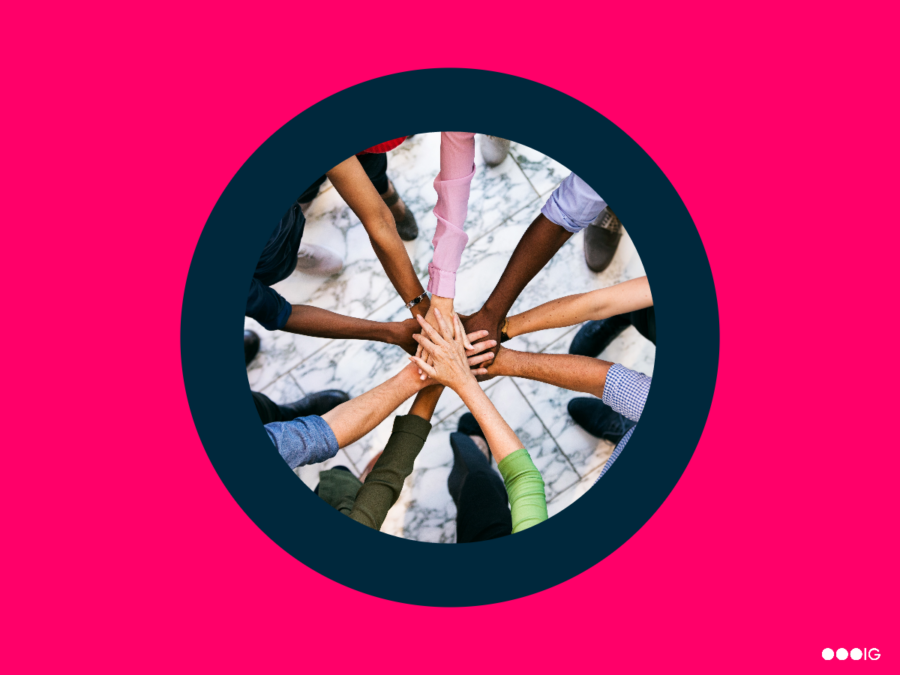More than three-quarters of surveyed companies say Diversity, Equity, Inclusion, and Belonging (DEIB) agendas are a business priority. As DEIB initiatives spark greater conversation and action in the workplace, what are practical ways organizations can celebrate diversity throughout the year? Let’s dive into the ways diversity can be celebrated and how to implement it successfully into your organization.
Why is Workplace Diversity Important to Celebrate?
There are countless studies confirming that diverse companies, especially those with diverse leadership, outperform their homogenous peers. Creating a diverse, inclusive workplace means that all employees feel included, safe, valued, and supported.
However, it’s not enough for an organization to announce a DEIB initiative. A Catalyst study of over 24,000 workers found that only 53% felt their organization was held accountable for DEIB. On top of that, only 37% of employees rated their organizational processes as “fair.”
When employees feel that their organization is held accountable for DEIB goals, they are twice as likely to feel included at work, be more engaged, and stay at the organization. When organizations implement equitable and fair processes for an inclusive workforce, employees are five times more likely to be engaged and stay long-term. It’s important for organizations to celebrate workplace diversity because it reinforces their DEIB goals in a tangible way.
Types of Diversity in the Workplace
Diversity is a spectrum that ranges across three primary dimensions: internal, external, and organizational diversity. When looking for ways to celebrate diversity in the workplace, be mindful of the three primary dimensions as well as the many subtypes of diverse workers, including but not limited to:
Internal Diversities:
- Race
- Ethnicity
- Gender
- Age
- Sexual orientation
- Physical or mental abilities
External Diversities
- Appearance
- Geographic location
- Socioeconomic background
- Personal habits such as dietary preferences
- Religious affiliation
- Educational background
- Past work experience
- Veteran status
- Parental status
- Marital status
Organizational Diversities:
- Worker’s functional level/classification
- Subject matter expertise
- Division/department/group/team/unit
- Seniority
- Work location (onsite, hybrid, remote, global or regional)
- Management status
- 8 Ways to Celebrate all Types of Workplace Diversity
Before you begin, conduct a comprehensive audit of your organization’s diverse landscape as well as existing DEIB policies (and their effect on diversity and inclusion). Then, explore the most effective ways to implement a combination of the following tactics.
Break Down Communication Barriers
More teams are becoming global or employing a mix of onsite and remote employees. You can help employees connect despite geographic or language differences by addressing barriers. Encourage the use of clear, concise, and jargon-free communication that is supported by visual aids such as diagrams or infographics to overcome language barriers.
Remove technological barriers by syncing up teams on communication platforms and establishing best practices like including agendas in calendar invites or having someone take notes in every meeting.
Hold Space for all Holidays
Diverse teams can have workers that observe a range of religious or cultural holidays. In addition to celebrating holidays like Christmas and Thanksgiving, many organizations are choosing to focus on celebrating underrepresented cultures. This can include other religious and faith traditions for people who identify as Jewish, Muslim, Buddhist, and Hindu as well as International Women’s Day, Black History Month, or Lunar New Year. When employees feel comfortable sharing their unique religious beliefs, cultures, and holidays, it provides a chance to celebrate and learn about new practices.
Create a Cultural Calendar or Company Dashboard
Help employees prepare for upcoming diversity celebrations by creating a centralized cultural calendar. Allow workers to submit cultural holidays or celebration suggestions to ensure that all communities are represented.
Creating opportunities for employees to share and learn about their colleague’s perspectives and cultures helps build appreciation and open-mindedness for cultural differences.
Offer Employee Diversity Training
Promote cultural awareness to help your workforce understand why cultural diversity and competence are necessary. Build diversity training into your onboarding process to explain the importance of diversity in your workplace and support it with official policies.
In addition to making diversity training a part of the onboarding process, consider offering ongoing cultural awareness or development workshops to further address business etiquette and culturally sensitive communication.
Communicate in Universal Ways
Ensure that organizational communication is culturally sensitive. When possible, include highly visual messages to reduce miscommunication and be mindful of communications across different time zones.
Create a universal sense of belonging by letting all your employees know they’re welcome to include pronouns in their email signatures as well as include photos in their company profiles.
RELATED: The Importance of Correct Pronouns in the Workplace
Support Employee Resource Groups
Employee resource groups (ERGs) are voluntary, employee-led groups that are formed around a shared culture, background, or identity. ERGs provide a safe space for employees to come together, support each other, share stories, and connect with one another. ERGs can help organizations better celebrate diversity in the workplace in a few ways:
- Create a sense of belonging. ERGs can provide a safe space for employees to connect with others who understand their experiences and perspectives. This can help to reduce potential feelings of isolation and exclusion, and it can also boost employee morale.
- Promote awareness and understanding of diversity. ERGs can help to raise awareness of different cultures, backgrounds, and experiences. This can help to break down stereotypes and promote understanding and acceptance of diversity.
- Provide support and resources. ERGs can provide support and resources to employees from underrepresented groups. This can include mentoring, networking opportunities, and training programs.
Commit to Organizational Fairness
One way for organizations to celebrate diversity in their decision-making processes is to have mechanisms in place for employees to provide feedback and input before decisions are made that will greatly affect them.
Senior leaders may not always understand how a business decision will impact employees of different socioeconomic, familial structures, or cultural backgrounds, so providing feedback loops for employees and information about employee outcomes can help workers feel more supported.
Reiterate Your DEI Commitments
Most importantly, employees want to feel like diversity is celebrated year-round and not simply a buzzword. This can be done by sharing organizational DEIB goals so employees can track progress and hold the business accountable. Reiterate your DEIB goals regularly and enact policies that show ongoing, unwavering commitment to those goals.
Learn How to Support Diversity in the Workplace with Insight Global
If your workplace could use additional guidance on celebrating diversity in the workplace, connect with Insight Global today. We offer a variety of DEIB training solutions—all tailored to your unique business needs.
Looking for DEIB Solutions?
Work with Insight Global to start building a diverse workforce.






 by Brita Long
by Brita Long 
 by Insight Global Staff
by Insight Global Staff 

 by Erin Ellison
by Erin Ellison